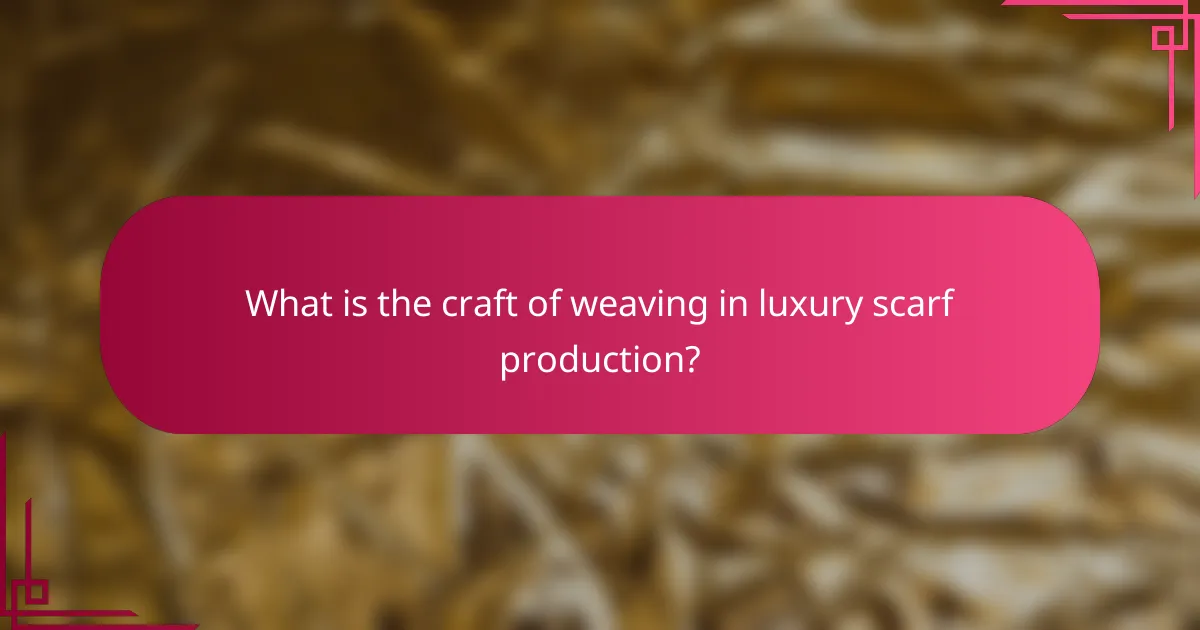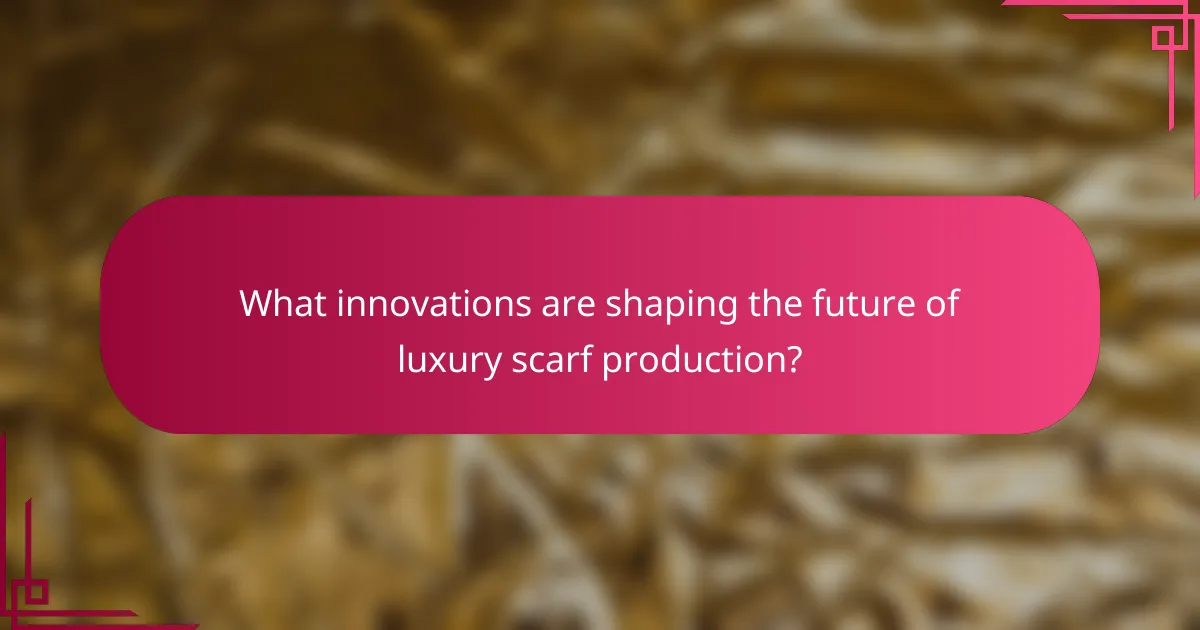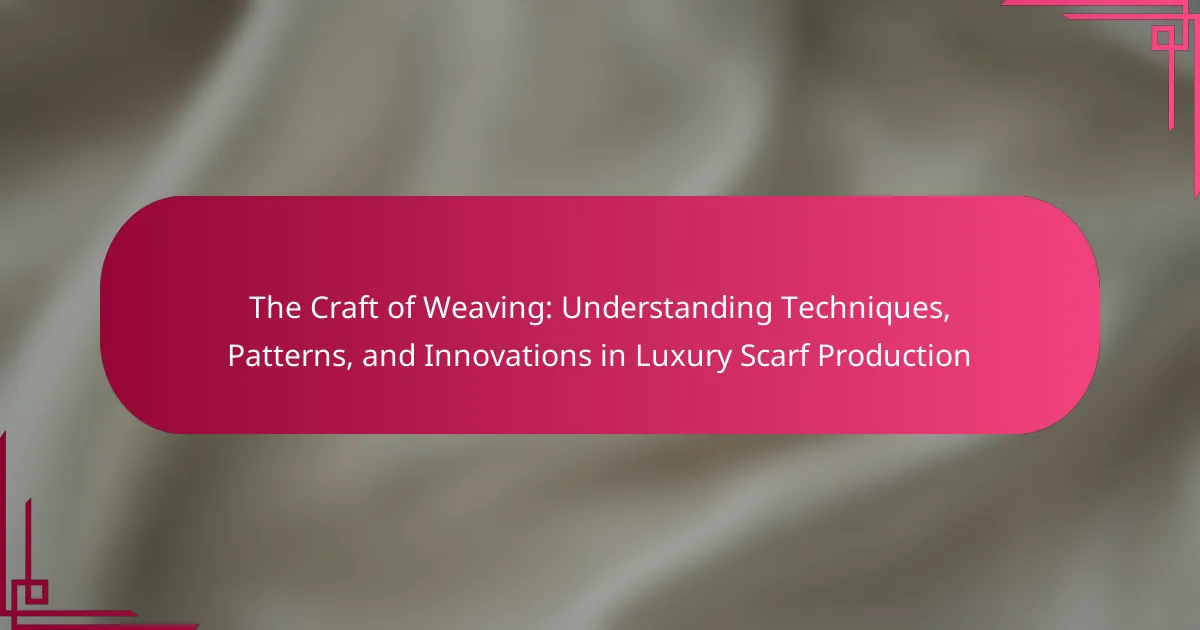The article explores the craft of weaving in luxury scarf production, highlighting intricate techniques that result in high-quality textiles. It discusses various weaving methods, such as jacquard and twill, and the use of premium materials like silk and cashmere, which enhance the scarves’ aesthetic and durability. Innovations in the industry, including sustainable materials and advanced weaving technologies, are transforming production processes and appealing to eco-conscious consumers. The article also addresses challenges faced by luxury scarf producers, including sourcing quality materials, maintaining consistent quality, and adapting to evolving fashion trends.

What is the craft of weaving in luxury scarf production?
The craft of weaving in luxury scarf production involves intricate techniques that create high-quality textiles. Weaving combines threads on a loom to form patterns and textures. This process requires skilled artisans who understand various weaving methods, such as jacquard and twill. Each technique contributes to the scarf’s unique aesthetic and functionality. High-end materials like silk and cashmere are often used, enhancing the final product’s luxury appeal. The precision in weaving ensures durability and a refined finish. Historical practices influence modern techniques, maintaining traditional craftsmanship. Luxury brands often emphasize the artistry involved in their production processes.
How has the craft of weaving evolved over time?
The craft of weaving has evolved significantly from ancient times to the present. Initially, weaving was a manual process using simple looms and natural fibers. Historical evidence shows that the earliest known woven textiles date back to around 5000 BCE in ancient Mesopotamia. Over centuries, advancements in loom technology occurred, allowing for more complex patterns and faster production. The introduction of mechanized looms during the Industrial Revolution in the 18th century drastically increased efficiency and accessibility. Today, weaving incorporates digital technology and innovative materials, expanding creative possibilities. Modern luxury scarf production often blends traditional techniques with contemporary designs, showcasing the craft’s rich history and ongoing evolution.
What traditional techniques are still relevant today?
Traditional weaving techniques such as handloom weaving, shuttle weaving, and tapestry weaving remain relevant today. Handloom weaving is valued for its artisanal quality and intricate designs. Shuttle weaving allows for faster production while maintaining traditional aesthetics. Tapestry weaving is used for creating detailed patterns and scenes, preserving cultural narratives. These techniques are still practiced globally, often in regions known for textile heritage. They contribute to sustainable fashion by promoting local craftsmanship. The revival of interest in handmade goods further supports their relevance in contemporary markets.
How do modern innovations influence traditional weaving methods?
Modern innovations significantly influence traditional weaving methods by integrating advanced technology and materials. Techniques such as digital weaving and automated looms enhance efficiency and precision. These innovations allow artisans to create intricate patterns that were previously difficult to achieve by hand. Additionally, modern dyes and synthetic fibers expand the color palette and durability of woven products. The use of software for design enables weavers to visualize and modify patterns easily. This blend of tradition and technology preserves cultural heritage while adapting to contemporary market demands. Studies show that these innovations can increase production rates by up to 50%, demonstrating their practical impact on traditional practices.
What are the key techniques used in luxury scarf weaving?
The key techniques used in luxury scarf weaving include jacquard weaving, twill weaving, and handloom weaving. Jacquard weaving allows for intricate patterns and designs through programmable controls. This technique enhances the visual complexity of scarves. Twill weaving creates a diagonal ribbing effect, providing durability and texture. Handloom weaving is a traditional method that emphasizes craftsmanship and uniqueness. Each of these techniques contributes to the luxurious quality of the final product. The combination of these methods results in scarves that are not only aesthetically pleasing but also functional.
What are the most common weaving techniques employed?
The most common weaving techniques employed include plain weave, twill weave, and satin weave. Plain weave is the simplest technique, involving alternating over and under threads. This method creates a strong and durable fabric. Twill weave features a diagonal pattern, resulting in a softer and more drapable textile. Satin weave produces a smooth surface with a glossy finish, often used for luxury items. Each technique offers distinct characteristics suitable for various applications in fabric production.
How do different techniques affect the final product’s quality?
Different weaving techniques significantly influence the final product’s quality. Techniques such as twill, satin, and plain weave each offer distinct properties. For example, twill weave creates a diagonal pattern that enhances durability and drape. Satin weave produces a smooth, glossy surface that elevates luxury appeal. Plain weave is simpler but offers a sturdy structure. The choice of technique affects the fabric’s texture, strength, and appearance. Research indicates that higher-quality weaving techniques lead to greater fabric longevity and aesthetic value. In luxury scarf production, the selected technique directly impacts consumer satisfaction and brand reputation.
What patterns are prevalent in luxury scarf designs?
Luxury scarf designs often feature intricate patterns such as paisley, floral, and geometric motifs. Paisley patterns are characterized by their teardrop shapes and elaborate detailing. Floral designs showcase various flowers and botanical elements, often in vibrant colors. Geometric motifs focus on shapes and lines, creating a modern aesthetic. Stripes and polka dots are also common, offering a classic touch. These patterns are usually printed or woven using high-quality materials like silk and cashmere. The craftsmanship involved reflects a long-standing tradition in textile design. Renowned fashion houses frequently utilize these patterns to enhance brand identity and appeal to luxury consumers.
How do cultural influences shape scarf patterns?
Cultural influences shape scarf patterns through traditional motifs, colors, and weaving techniques. Different cultures have unique symbols and designs that reflect their heritage. For example, paisley patterns originate from Persian culture, while tartan patterns are associated with Scottish clans. The choice of colors often carries cultural significance, such as red symbolizing good fortune in Chinese culture. Additionally, weaving techniques vary globally, impacting the texture and appearance of scarves. These cultural elements are often passed down through generations, preserving history and identity. Scarf patterns thus serve as a visual representation of cultural narratives and values.
What role do color and texture play in pattern design?
Color and texture are fundamental elements in pattern design. Color influences mood, perception, and visual appeal. Different colors can evoke specific emotions and attract attention. For example, warm colors like red and orange can create a sense of warmth and energy. Cool colors like blue and green often convey calmness and tranquility.
Texture adds depth and dimension to patterns. It can create visual interest and tactile experiences. Various textures can enhance the perception of luxury in scarf design. For instance, a soft, plush texture may suggest comfort, while a smooth texture can imply elegance.
Together, color and texture work to create cohesive and engaging patterns. Effective use of these elements can differentiate products in a competitive market. According to research by the Color Marketing Group, color can increase brand recognition by up to 80%. This demonstrates the significant impact of color in design.

What innovations are shaping the future of luxury scarf production?
Innovations shaping the future of luxury scarf production include sustainable materials, advanced weaving technologies, and digital printing techniques. Sustainable materials like organic cotton and recycled fibers are gaining popularity. These materials reduce environmental impact while maintaining quality. Advanced weaving technologies, such as Jacquard looms, enhance design complexity and precision. Digital printing techniques allow for intricate patterns and customization options. These innovations enable brands to offer unique products that appeal to eco-conscious consumers. The integration of technology in production processes also increases efficiency and reduces waste. Overall, these advancements are transforming the luxury scarf industry into a more innovative and sustainable sector.
How is technology impacting the weaving process?
Technology is significantly transforming the weaving process. Automated looms increase production speed and efficiency. These machines enable precise control over patterns and designs. Digital weaving technology allows for intricate designs that were previously difficult to achieve. Software programs assist in planning and visualizing patterns before production. This reduces material waste and enhances creativity. Innovations like 3D weaving create complex structures not possible with traditional methods. Overall, technology enhances productivity while expanding artistic possibilities in weaving.
What new tools and machinery are being introduced?
New tools and machinery being introduced in luxury scarf production include advanced Jacquard looms. These looms allow for intricate pattern designs with high precision. Additionally, digital weaving machines are being utilized for faster production times. These machines can create complex patterns directly from digital files. Automation technology is also being integrated to enhance efficiency. This includes robotic arms for handling materials and finished products. Furthermore, eco-friendly dyeing machines are being adopted to reduce environmental impact. These innovations improve both the quality and sustainability of scarf production.
How do these innovations improve efficiency and quality?
Innovations in luxury scarf production enhance efficiency and quality by streamlining processes and improving materials. Automated weaving machines significantly reduce production time. These machines can operate continuously, leading to higher output. Advanced materials also contribute to better durability and feel. Innovations like digital printing allow for intricate designs without compromising fabric integrity. Quality control systems ensure that each scarf meets high standards. The integration of technology reduces human error in production. Overall, these innovations create a more efficient workflow while elevating the end product’s quality.
What sustainable practices are emerging in scarf production?
Sustainable practices in scarf production include the use of organic materials and eco-friendly dyes. Manufacturers are increasingly opting for organic cotton, linen, and bamboo. These materials reduce the environmental impact associated with conventional farming. Additionally, many brands are adopting low-impact dyeing processes. These processes minimize water usage and eliminate harmful chemicals. Recycling and upcycling are also gaining traction in scarf production. Brands are repurposing fabric scraps to create new designs. Furthermore, local sourcing of materials is becoming common. This practice supports local economies and reduces carbon footprints. Finally, transparency in supply chains is emphasized. Consumers are increasingly demanding information about sourcing and production practices.
How are brands integrating eco-friendly materials?
Brands are integrating eco-friendly materials by sourcing sustainable fibers and utilizing recycled materials. Many luxury scarf producers are adopting organic cotton, Tencel, and hemp as alternatives to conventional fabrics. These materials reduce environmental impact through lower water usage and chemical avoidance. Additionally, brands are incorporating recycled polyester made from plastic bottles to minimize waste. Certifications like Global Organic Textile Standard (GOTS) ensure the sustainability of the materials used. Research indicates that the global market for sustainable textiles is expected to grow significantly, reflecting consumer demand for eco-friendly products. This shift demonstrates a commitment to environmental responsibility within the luxury fashion industry.
What are the benefits of sustainable weaving practices?
Sustainable weaving practices provide environmental, social, and economic benefits. They reduce waste by utilizing eco-friendly materials and minimizing resource consumption. This approach conserves water and energy compared to conventional methods. Sustainable weaving also promotes fair labor practices, ensuring workers receive fair wages and safe working conditions. Additionally, it supports local economies by sourcing materials from nearby suppliers. Research indicates that sustainable textile production can lower carbon emissions significantly. According to a study by the Ellen MacArthur Foundation, circular fashion initiatives can reduce greenhouse gas emissions by up to 45% by 2030.

What are the challenges faced in luxury scarf production?
Luxury scarf production faces several challenges. Sourcing high-quality materials is often difficult. Premium fabrics like silk or cashmere require careful selection. The production process is labor-intensive and demands skilled artisans. Maintaining consistent quality across batches is a significant hurdle. Additionally, the market is highly competitive, putting pressure on pricing. Sustainability concerns also affect sourcing and production methods. Lastly, evolving fashion trends require constant innovation in design and technique. These factors collectively impact the overall production of luxury scarves.
What are the common obstacles in sourcing materials?
Common obstacles in sourcing materials include supply chain disruptions, quality inconsistencies, and cost fluctuations. Supply chain disruptions can arise from geopolitical issues or natural disasters, affecting availability. Quality inconsistencies occur when suppliers do not meet the required standards for luxury materials. Cost fluctuations can be influenced by market demand and raw material scarcity. Additionally, limited supplier options can restrict choices for unique fabrics. Regulatory compliance can complicate sourcing efforts, especially for imported materials. These challenges can impact production timelines and overall product quality.
How do economic factors influence material availability?
Economic factors significantly influence material availability in luxury scarf production. Fluctuations in raw material prices directly affect supply levels. For instance, a rise in cotton prices can limit access to high-quality fibers. Additionally, economic downturns may reduce demand for luxury goods, impacting production volumes. Supply chain disruptions due to economic instability can further restrict material availability. Historical data shows that during recessions, luxury textile production often declines, leading to material shortages. Currency exchange rates also play a role, affecting import costs of specialized materials. Thus, economic conditions shape the landscape of material availability in the luxury scarf market.
What are the implications of quality control in production?
Quality control in production ensures that products meet specific standards and specifications. It minimizes defects and enhances overall product reliability. Effective quality control can lead to increased customer satisfaction and brand loyalty. It also reduces costs associated with waste and rework. Implementing quality control measures can improve operational efficiency. Additionally, it can enhance compliance with industry regulations. Studies show that companies with strong quality control processes have higher profitability. For example, a report by the American Society for Quality indicates that organizations with robust quality practices experience a 10-20% reduction in costs.
How can artisans maintain craftsmanship in a fast-paced market?
Artisans can maintain craftsmanship in a fast-paced market by prioritizing quality over quantity. They should focus on using high-quality materials that enhance the final product. This commitment to quality can set their work apart from mass-produced items. Additionally, artisans can invest time in honing their skills through continuous learning and practice. Workshops and training programs can provide valuable techniques and innovations. Collaborating with other artisans can also foster knowledge sharing and inspire creativity. Establishing a strong brand identity helps artisans communicate their unique value to consumers. Engaging with customers through storytelling can create a connection that emphasizes the craftsmanship involved. By maintaining these practices, artisans can thrive in a competitive environment while preserving their craft.
What strategies can be employed to preserve traditional techniques?
To preserve traditional weaving techniques, education and training programs should be established. These programs can teach younger generations the skills and knowledge required for traditional weaving. Workshops with master weavers can provide hands-on experience. Documentation of techniques through videos and written guides can also serve as valuable resources. Collaborations with artisans can help in sharing best practices. Additionally, promoting traditional crafts through exhibitions can increase public interest. Financial support for artisans can ensure their practices continue. Lastly, integrating traditional techniques into modern designs can enhance their relevance.
How can artisans balance innovation with craftsmanship?
Artisans can balance innovation with craftsmanship by integrating modern techniques while preserving traditional methods. They can adopt new materials that enhance durability and aesthetics without compromising quality. Techniques like digital design can streamline production and allow for unique patterns. However, artisans must ensure that these innovations align with their craftsmanship values. Regular workshops can help artisans learn about new technologies while refining their skills. This approach maintains the integrity of their work. Historical examples show that artisans who embraced innovation often expanded their market reach. The fusion of old and new can create distinctive products that appeal to modern consumers.
What tips can enhance the luxury scarf production process?
Investing in high-quality materials enhances the luxury scarf production process. Natural fibers like silk and cashmere provide superior texture and durability. Implementing advanced weaving techniques improves design intricacy and craftsmanship. Training skilled artisans ensures consistent quality and attention to detail. Utilizing modern technology for precision can streamline production without sacrificing quality. Regular quality control checks maintain high standards throughout the process. Collaborating with designers for unique patterns can elevate the product’s appeal. Sustainable practices in sourcing materials can attract eco-conscious consumers and enhance brand reputation.
How can artisans improve their weaving skills?
Artisans can improve their weaving skills through practice, education, and experimentation. Regularly practicing various techniques enhances muscle memory and skill proficiency. Attending workshops or classes provides structured learning and expert guidance. Studying different weaving patterns broadens knowledge and inspires creativity. Utilizing high-quality materials can lead to better outcomes and satisfaction. Engaging with a community of weavers fosters sharing of tips and experiences. Analyzing historical weaving techniques can introduce traditional methods that enhance modern practices. Lastly, keeping a portfolio of work allows artisans to track progress and identify areas for improvement.
What best practices should be followed for quality assurance?
Implementing best practices for quality assurance in luxury scarf production involves several key strategies. First, establish clear quality standards that align with industry benchmarks. Regularly review and update these standards to reflect market trends. Next, conduct thorough inspections at every production stage. This includes raw material checks, weaving processes, and final product evaluations.
Additionally, invest in training for all employees involved in production. Skilled workers are crucial for maintaining quality. Utilize advanced technology for monitoring and testing materials. This can help identify potential issues early in the production process.
Finally, gather customer feedback to understand satisfaction levels. This feedback can guide improvements in quality assurance practices. Following these strategies ensures a consistent and high-quality product in luxury scarf production.
The main entity of this article is the craft of weaving in luxury scarf production. The article provides an in-depth analysis of various weaving techniques, such as jacquard, twill, and handloom weaving, highlighting their impact on the quality and aesthetics of scarves. It also explores the evolution of weaving from traditional methods to modern innovations, including sustainable practices and advanced technologies that enhance efficiency and design complexity. Additionally, the article discusses prevalent patterns in luxury scarf designs, the influence of cultural elements, and the challenges faced in sourcing high-quality materials. Overall, it emphasizes the balance between craftsmanship and innovation in the luxury textile industry.
